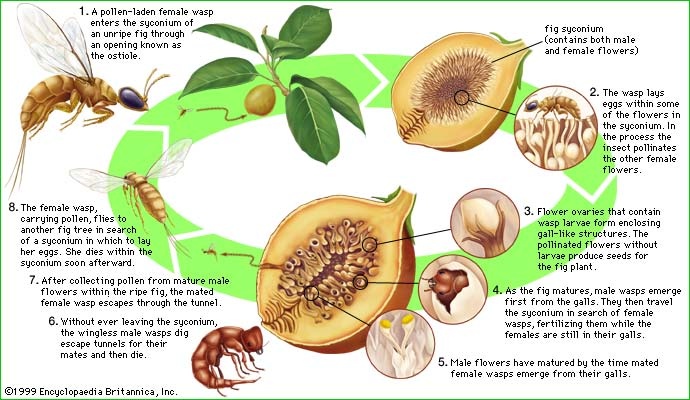Ficus
plant genus
a group of about 900 species of trees, shrubs, and vines, commonly called figs. Native primarily to tropical areas of East Asia, they are distributed throughout the world's tropics. Many are tall forest trees that are buttressed by great spreading roots; others are planted as ornamentals.
The common fig (Ficus carica) is cultivated for its pear-shaped, edible fruits, which are really hollow fleshy receptacles (syconia) containing hundreds of male and female flowers.
Some fig species (including the New World F. obtusifolia and F. nymphaeifolia) are known as strangler figs (strangler fig). The seeds of strangler figs germinate on a host tree and grow around its trunk in a strangling latticework, eventually killing the host tree. One freestanding New World species, F. insipida, has the highest photosynthetic rate of any forest tree measured, supporting rapid growth and abundant fruiting. It can quickly colonize abandoned farm fields in large numbers, but as the forest matures, most die as other plants take over.
 Each fig species is pollinated by a species-specific wasp (see fig wasp). This remarkable pollination system has a fundamental impact on tropical forest ecology. When the pollen-bearing wasps leave a fig tree, the fruit crop ripens quickly, providing a rich feast that attracts a host of mammals and birds. Moreover, as a consequence of the wasp's short adult lifetime (as little as two days), there are some trees both receiving and releasing fig wasps throughout the year. This pattern results in a steady supply of fruit, making figs a critical resource for animals during times of food shortage. If figs were to be cut out of a forest or the fig wasps were to somehow be removed, there would almost certainly be a dramatic reduction in animal life, as is suggested by the lower population densities of fruit-eating mammals on small islands that lack figs.
Each fig species is pollinated by a species-specific wasp (see fig wasp). This remarkable pollination system has a fundamental impact on tropical forest ecology. When the pollen-bearing wasps leave a fig tree, the fruit crop ripens quickly, providing a rich feast that attracts a host of mammals and birds. Moreover, as a consequence of the wasp's short adult lifetime (as little as two days), there are some trees both receiving and releasing fig wasps throughout the year. This pattern results in a steady supply of fruit, making figs a critical resource for animals during times of food shortage. If figs were to be cut out of a forest or the fig wasps were to somehow be removed, there would almost certainly be a dramatic reduction in animal life, as is suggested by the lower population densities of fruit-eating mammals on small islands that lack figs.Another notable Ficus species is the sycamore fig (F. sycomorus), which has mulberry-like leaves, hard wood, and edible fruit. The banyan (F. benghalensis) and some related species have aerial roots that become greatly enlarged and spread away from the main stem, acting as auxiliary trunks to support the massive crowns. The India rubber plant (F. elastica), a large tree that was formerly an important source of rubber, is now cultivated as an indoor potted plant. The fiddle-leaf fig (F. lyrata), the weeping fig (F. benjamina), and some climbing species such as the climbing fig (F. pumila) are popular ornamentals. The Bo tree, or pipal (F. religiosa), is sacred in India because of its association with the Buddha. This and all Ficus species are members of the mulberry family (see Moraceae).
- James Andrew Broun Ramsay, Marquess and 10th Earl of Dalhousie
- James Anthony Froude
- James A(rthur), Jr. Lovell
- James A(rthur) Lovell, Jr.
- James Augustine Healy
- James Augustus Grant
- James A. Van Allen
- James Baldwin
- James, Baron Ensor
- James Barry
- James Batcheller Sumner
- James Bay
- James B. Conant
- James B. Eads
- James Beard
- James Beaton
- James Beattie
- James Beaumont Neilson
- James Bicheno Francis
- James Biddle
- James B. Irwin
- James Blair
- James B. McPherson
- James Bogardus
- James Bond